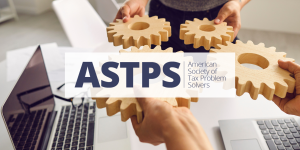Benjamin Franklin said it best, “Time is money.” If you are lagging behind on your tax business’s workflow, then it’s time to explore effective time management solutions such as automated tax solutions.
Tax resolution professionals struggle to keep pace with their clients’ needs. Tax season accelerates things to a fever pitch and many start to feel like they are slipping as the workload builds. Automation for tax professionals promises to streamline the workflow, especially when coupled with tax resolution software. What once took hours to accomplish now takes minutes so you can get a lot more done with minimal effort and time.
Automation coupled with taxation does spur a variety of legal concerns and worker’s rights dilemmas. Despite the reservations of many, automated tax solutions can grow your tax business and is the wave of the future.
The Fourth Industrial Revolution
The so-called ‘Fourth Industrial Revolution’ is 100% digital. It follows the other globally significant revolutions of water/steam power, electrical, and electrons/information technologies. The digital revolution embraces converging technologies that include digital, physical, industry sectors, and biological spheres in an effort to transform the client and employee experiences while meeting expectations.
The escalating use of blockchain general ledgers, machine learning, artificial intelligence (AI) and cloud computing is revolutionizing tax functions. The world is changing – even the tax world. The United Kingdom recently launched its ‘Making Tax Digital’ initiative which focused on fully digitizing the U.K’s tax system in 2020, in an effort to improve the quality and efficiency of tax administration. Other nations will soon follow in increasing numbers.
Staying ahead of the ever-changing tax world is a challenge. Tax rates and rules are constantly updating and modifying. Tax automation software helps you stay ahead of the curve.
Diane L. Yetter, with the Sales Tax Institute says, “by various estimates, there are between 7,500 and 14,000 different authorities that impose a sales tax in the U.S. alone. Think of all the different people that participate in making sales and use tax decisions within your company. Are you confident that each of these individuals is making the right decision when it comes to sales and use tax?” With tax automation you reduce the likelihood of errors and increase accuracy.
What is Tax Automation?
For decades tax professionals have relied on manually completing tasks and filling out forms. However, tax automation software is an effective way to automatically record data and save it in a searchable format.
There is a wide assortment of software available and businesses differ in how they use it and to what extent. Some tax software captures data from tax forms that are manually filled, and others start from the beginning with the accounting and bookkeeping processes. Another example is tax resolution software, which offers different tools and worksheets for managing resolution cases and understanding what is needed from the IRS.
Automation is all about freeing up the time of employees, so they can perform higher-value work. The technology used to achieve this can include business process automation (BPA), AI-powered automation, and robotic process automation (RPA). Saving time and allowing resources to be diverted to more pressing tasks increases your business’s productivity and profitability.
Understanding Automation
Automation is truly diverse and now in use by every industry, from warehouse assembly lines to healthcare systems, to tax resolution businesses. All are starting to rely heavily on automation software to meet their remarkably diverse needs.
Artificial intelligence (AI), coupled with machine learning, is also taking automation to unimagined levels. This form of automation is referred to as ‘intelligent automation’ and it’s definitely changing the way machines and humans interact. With automation, efficiency is increased, which drives revenue, and helps businesses stay competitive, like tax firms, and meet the needs of the challenging markets.
The bottom-line benefits of automation cannot be ignored. The IBM Institute of Business Value recently released projected research that showed automation, with the support of AI, is set to generate bills of dollars in labor savings in 2022.
Business automation is an overly broad term, but it encompasses the use of technology applications that help to perform repetitive tasks and free employees’ time – clearly a win/win for any tax business that is struggling with a heavy client load during certain times of the year, like tax season.
The Evolution of Modern Business Automation

Not that long ago, automation needed massive (think room-sized) mainframes and a large team of highly skilled experts to maintain the complex systems. Today, cloud-based automated platforms function well for companies of all sizes. Whether you have a solo tax firm or a large, thriving business, your company can easily rely on cloud-based automation platforms.
-
Basic Automation:
With basic automation, rudimentary tasks are easily automated. There is no complex coding required. The automation tools effortlessly digitize the repetitive tasks to help eliminate errors in your tax business and quickly accelerate the pace of your workflow. Business process management (BPM) and robotic process automation (RPA) are examples of what is considered “basic” automation.
-
Process Automation:
Process automation manages business functions with transparency and complete uniformity. The process is managed by dedicated software. Automation increases productivity and delivers valuable business insights. Workflow automation and process mining are all forms of process automation.
-
Advanced Automation:
With advanced automation, there is a joining of the human component which integrates across multiple systems and organizations. This is a complex process. It is often used for safety monitoring, error detection, or maintenance/repair. Advanced automation depends on unstructured data that is coupled with machine learning analysis, and natural language processing. It is ideal for knowledge management and decision support that is used for very specialized work in the business world. An example is a safety monitoring system, which might sound an alarm if a person gets dangerously close to an automated system. Advanced automation is probably not going to be used by most tax businesses.
-
Intelligent Automation:
“Intelligent automation” refers to a machine’s ability to make decisions and learn from exposure to certain situations. The machine analyzes what it encounters. This is referred to as artificial intelligence (AI). You might think that your tax business doesn’t need anything as sophisticated as AI but virtual assistants and chatbots are all forms of AI, which are beneficial in customer service and for use on your website: they drive traffic and convert them into clients. AI fosters smarter interactions between humans and customers which refines and enhances the entire customer service experience and takes it to the next level. It is a form of automation that is definitely worth consideration for any tax business.
Why is Business Automation Important?
Whether you are running a solo tax business or a large, growing firm, automation is an excellent option to streamline your office operations and push your business growth. Automation tools are even designed to replace some aspects of human labor, so you can use those resources elsewhere in your business.
To truly grasp the full potential of automation, you’ll need to consistently use automation software across all workflows to create a faster and improved digital customer experience and further simplify your internal processes.
Using Business Automation
Business automation has become a necessity for any organization, whether you are operating a tax resolution business or some other company. The common uses of business automation software all share standard features.
It’s all about reducing the workload and freeing up employee time while enhancing your client satisfaction. The common goal is to increase your business efficiency and grow your bottom line. Overall, the use of business automation is very black and white with set goals.
-
Marketing Activities:
Email marketing automation lets a company send out emails to a client list for distribution following a very predefined schedule. It reduces the cost of running campaigns manually.
Marketing is a vital component of any business, even tax businesses. Marketing efforts are often linked to customer relationship management (CRM) systems. Some software systems even let you target customers with automated messages using social media. When it comes to marketing, the sky’s the limit with business automation as it constantly evolves.
-
Human Resources:
Your HR department can benefit from many automated tasks such as job application processing, employment offers, onboarding, payroll processing, payroll management, and benefits administration. The use of analytics will also offer insights in the workforce productivity.
-
Sales:
Using sales automation tools, you can spend less time making phone calls and reaching out to potential clients. The tools effectively automate most repetitive tasks that are conducted in the sales process such as qualifying leads based on the journey of the buyer and then creating potential client forecasts.
-
Finance and Accounting:
Automating your financial and accounting processes is a big boon to most businesses because it frees up employees. The automation software performs analysis, strategies, and collaborations. Data capture is automated, invoices matched to documents and more. Data areas are significantly reduced due to automation.
Benefits of Tax Automation
Below is a list of a few benefits of automating your tax preparation or resolution business. A tax professional should weigh each perk to decide if automated tax solutions are the right choice for their particular needs.
- Rapid processing of all financial figures and transactions.
- Easy, stress-free tax filing.
- Accurate record keeping.
- Exceptional cost savings due to a reduction in manual labor expenses.
- Ability to stay current with tax exemptions, obligations, and structures.
- Higher business saving.
- Accomplish repetitive tasks rapidly.
- Gather and save copious quantities of data.
- Streamline workflow.
- Effortlessly gather data.
- Improved customer service.
- Easier to gather data for future use.
- Improved communication with the IRS.
Choosing Tax Business Automation Software
If you start researching tax business automation software, you’ll soon discover that you have a variety of choices. However, remember, not all automation software is created equally.
There is a full range of technology that is needed to fully automate any end-to-end operations so when picking automation software for your tax business, you’ll want to weigh all of the factors. Figure out what services are important to your particular business.
Business automation software is changing the world. Automation helps you manage the experiences that you offer your customers. Automation combined with AI can help you drive traffic and grow your business by reaching more clients plus providing greater customer satisfaction.
You’ll need to decide which automation platform fits your needs by weighing the following:
Discover Processes:
Try to pinpoint inefficiencies in your business or hotspots in your tax firm’s operations to determine which automated processes will meet your needs and have the greatest impact on your business.
Refer to the Data:
Consider your data needs and how you want to automate your operations. Do you want to free up your employees for more important tasks? Is AI an option for your website? Consider how high you can take productivity with whatever automation software you are considering.
Automation of Core Operations:
Apply automation to your core operations – document processing, decision management, content services, workflow orchestration, scheduling, and more. Make a list of your operational areas that you want to automate in your tax business and ensure that the cloud-based tax software you are considering will meet your automation needs.
Types of Automation Software
Automation software makes certain business functions ‘automatic’ which reduces hours wasted on repetitive tasks and improves productivity. When shopping for business automation, you’ll encounter four common types or a combination of the types.
Marketing Automation
Marketing is an important part of any type of business that is costly and laborious. Automation helps simplify the process. You can generate high quality leads which are ready for sales management. The tools also provide a sturdy framework for teams to target, enhance and implement. The goal is to take the complexity away from lead qualification and conversion.
Depending on the marketing automation software, you can automate the email marketing process so your sales team can launch campaigns. Many companies also rely on marketing automation to track and measure activity, identify leads, and then deliver them.
Marketing software is effective for companies of all sizes. A small company can use the software to develop, generate and send a variety of monthly emails.
Larger companies can use marketing automation to segment their customer data, target customers with automated messages either via text or social media and customize workflows to meet their particular needs.
With automation of online marketing and lead generation campaigns, a company can reduce the cost of developing campaigns. They can then achieve a higher measurable return on investment.
Accounting and Bookkeeping Automation
Automating accounting and bookkeeping saves time on accounts payable, billing, accounts receivable, collections, data backup, credit card applications, and other financial processes. They can then be managed either daily or weekly. Other automation options include management of a general ledger or bank account management. Automation makes complex account processes far more manageable.
An automated system for business finance management saves time and money. Invoices are automatically generated, and all documents are electronically routed. A significant reduction in errors is also highly beneficial.
Accounts payable automation frees up cash flow. Your team can submit invoices, process payments, and manage approvals in a single platform with improved visibility and control over other crucial financial processes.
Historically, accounting has been a time-consuming process by avoiding manual steps, time is made for other things like analysis, strategy, and team member collaboration.
Process Automation
Business process automation (BPA) is more than basic automation. It incorporates integration of various applications to help companies improve their value and efficiency. Robotic process automation (RPA) is a subset of BPA and automates routine tasks. With BPA, data is aggregated across multiple sources to develop analysis that would be hard to obtain manually.
BPA is often used for:
- Batch processing
- Report generation
- Distribution
- File transfers
- Order entry
- Emails
Tax businesses especially benefit from many aspects of BPA which effectively simplifies things, improves workflow, and replaces manual labor processes. Email chains and document transfers are streamlined for ease.
HR Automation
Hiring a new employee takes multiple steps before onboarding. HR automation automates the candidate management process. Everything from interview scheduling to handling job applications and making offers is quickly automated.
HR automation software also manages:
- Employee records and retrieval.
- Job applications.
- Work contracts.
- Agreements.
- Employee tax forms.
- Benefit enrollment.
- Employee training requirements.
HR departments use the system’s data to keep track of tasks for all employees of the company and generate reports for the business owner and managers.
Practice Management Automation
A practice management automation system is cloud-based software that helps you automate your day-to-day operations. This form of software is often favored by medical practices. You can quickly schedule appointments, carry out all billing processes, manage data, and rely on report generation. A practice management system is geared towards administrative tasks. It is easy to integrate, secure and improves workflow. It delivers real time analytics that you can control through a dashboard and customize if needed.
Tax Resolution Automation
The tax environment is ever-changing, so you need automated software that stays current, so your business never misses a beat – especially for tax resolution cases. Adding tax resolution into your portfolio of services is an excellent way to generate more revenue year-round and do so without any added stress or time.
Tax resolution software lets you get started easily and quickly, and offers tools that allow you to stay ahead of due dates, access IRS programs such as IRS e-services for downloading transcripts, prefilling up to date IRS forms, conduct rapid onboarding, use practice management tools, and more to streamline your business. Some also offer helpful marketing perks to hone your brand to reach more clients.
Adding Tax Automation to a Tax Practice

So, do you want to take the big step and add tax automation to your practice? It is complex and challenging when you add technology coupled with automation to an existing practice.
Below you’ll find a few steps you should take to effectively leverage technology to start automating your tax and accounting practice.
- Talk with the owner of the practice about embracing tax automation software (if you are not the owner).
- Partner with a colleague to push the positives of automation in your practice. You want everyone in the office to embrace the software transition.
- Draft a time. Consult with your partners to determine the best and most efficient way. Integration is an important process that saves time and increases efficiency within the entire organization.
- Check your basic technology to ensure that it is up to date enough to upgrade. Things like computers, printers, monitors, and scanners might need to be upgraded to handle the new, power-hungry automation software without bogging down, freezing, or malfunctioning.
Identifying What to Automate
As the owner of a tax business, you’ll need to decide what to automate. There are two components, what you can automate and what you should automate. You’ll need to identify both and then start making choices.
“Should Automate” Tasks
The following tasks should be automated:
- Tasks that are frequently performed (repeatable).
- Things that take an excessive amount of manual time which impacts your business’s bottom line.
- Simple decisions.
Let’s take a closer look at the day-to-day tasks that you can effectively automate with user friendly tech automation for tax businesses.
Answering the Phone
With automated phone answering, you can free up your staff to more pressing matters plus ensure that your clients get a prompt and professional response every time they call. The system will even direct the caller to the person they are trying to reach in the office.

Appointment Scheduling and Meetings
Scheduling software lets clients book their own appointments effortlessly online. It will then automatically fill in all of the key information on the lander and send you the notifications plus information to the client who has scheduled the appointment. If necessary, you can also add appointments manually if a client calls to schedule an appointment or meeting or cancel.
Virtual Meetings
Tax professionals often collaborate with long-distance clients or individuals who do not wish to leave home due to the Covid19 pandemic. They are an essential tool nowadays and automation software lets you send invites and reminders to your clients so they can effortlessly create, accept, or cancel meeting invitations.
Client Reminder Emails
Keep track of clients so you know who has filed their return for the current year and who has not. The automation software can create two separate lists to let you instantly send out notes to clients thanking them for their business and also draft emails to those who still need to file.
Scheduling Email Responses
Automatically schedule email responses via Outlook, Gmail, or other email services. The automation software lets you schedule emails and then have them sent automatically on certain days or times. This is highly beneficial for clients that you don’t want to bother on evenings or weekends.
Onboarding Services
When you onboard a new client, you are faced with a variety of repetitive tasks. The client is asked to enter their information on a form and then you must manually add the information into a database. After, you’ll typically send out a thank you or welcome letter. The entire process is time consuming and open to error since it is being carried out manually.
Digitized onboarding processes are wonderfully easy and streamlined. A client’s information is automatically added into the database when they fill out the form. You can effectively automate several steps at one time such as creating a new client filing, drafting, and sending emails, and assisting clients with scheduling. Once they enter their information into the database, future correspondences and scheduling becomes even easier.
Recurring Payments
Tax professionals don’t just work during tax season. Many tax businesses collaborate with their clients year-round and continue to receive recurring payments. Automated software lets you set up client payments with ease and issue invoices. You can save time for your client and your staff.
Business Mileage Monitoring
Business mileage monitoring tracks all mileage related to your business. It will automatically track the minute your auto starts moving or stops when you reach your destination. You can then effortlessly categorize every trip you make as either business related or personal. If you rarely travel for business, then you can change settings to track the trip only if you open the app.
Obtaining Signatures
With an electronic signature pad, clients can easily add signatures to their electronic concerns without worrying about printing, signing, and scanning. You can send documents electronically for signatures to long distance clients or those who do not want to physically come into the office. The process saves a considerable amount of time and also money.
Document Management
Digitizing all of your documents helps you stay organized and increases efficiency. You can free yourself from being a slave to paper. You can also rest assured that with cloud-based automated software, all of your files are safely stored and within easy access from anywhere. Cloud-based software lets you work from home or anywhere in the world as long as you have internet access. You’ll enjoy the ease of paperless document sharing and signing. Automated tax resolution has never been easier.
Welcoming Tax Automation to Your Tax Business

If you are operating a leading tax business, regardless of size, you know that employee time and expertise is not cheap. It comes at a high price, but it’s worth it to offer the best service. However, you can save money with tax automation and who doesn’t want to do that? The goal of any business is to increase the bottom line.
Without effective automation, your team is buried in an endless list of tedious tasks that could be offloaded with software. Think about the time you would save! Every time you spend on a redundant task is an hour that you lose which you could have been using to focus on more important aspects of your business!
Automation for tax practices is no longer a luxury enjoyed by big tax firms, it is now a necessity for businesses of all sizes to flourish and remain competitive.
Compliance Automation
Government requirements are endless and ever-changing. Rates, tax laws, and taxability rules remain in a constant state of flux and that’s just the business. However, automating your business helps reduce unnecessary risk. Humans make mistakes and software rarely (if ever) makes an error.
Automation software keeps your tax business up to date on rules and rates so you can maintain a cloud-based tax engine that helps increase your business’s accuracy, so you worry less about tax compliance. Using automation software helps stay up to date with rate calculations so they are accurate. Returns are always filed on time. Your exemption certificates are accessible and up to date. You are also registered in all the right locations.
Grow and Scale Your Tax Business
Are you ready to expand your business? Tax automation software lets you grow and scale with ease. Bring in new employees, products, and services. Only focused on tax preparation cases? Add tax resolution to your portfolio and generate year-round income!
You can even work with international markets which might appear too complicated at first with the additional tax jurisdictions and value added tax (VST) and goods and services tax (GST) that are all combined with different U.S. sales taxes. Yes, all countries’ tax rules are different. However, if you are dreaming of expanding your tax business for global reach then tax automation can help you reach your goals.
Staying Ahead with Your Tax Business
For the typical tax business, staying ahead is one of the biggest challenges. You have to keep up with everything while overseeing more clients and tackling growing administrative tasks. Trying to manage your tax practice has become a juggling act, especially during tax season when everything speeds up.
When your practice is small or you are operating as a solo tax provider, things are a little bit easier, but once your practice starts to grow then things rapidly become busier.
Yes, you get to enjoy a greater sense of success and you feel proud of your growing business, but things can quickly become overwhelming, and you need to stay ahead of the game. The best way to oversee your growing practice is to rely on automation software to better manage clients and conduct automation tasks.
Automating Workflow
Workflow encompasses all of the actions that you take from the minute that a client becomes a lead to the moment they are finally onboarded through the tax services you provide until the final touchpoint with the client. Every service provided requires varying steps to accomplish whether you are assisting with an individual tax return or working on a business or sales return. Automating administrative tasks is a fantastic way to smooth out the workflow, save time, and increase the effectiveness of your services.
IRS Solutions Software for Tax Professionals

As you can see from this article, there is a wide assortment of automated tax solutions that a business can use. However, if you want to grow your tax business then choosing software that provides you with the tax focused tools, systems and knowledge is imperative.
IRS Solutions provides the tools tax professionals need to work efficiently and stop wasting time dealing with the IRS. You’ll have access to all of the latest forms and the notices that the IRS typically uses for collections and audits.
IRS Solutions is a Tax Pro’s Best Friend. We can provide you with the tools you need to effectively market your tax resolution business, provide full IRS Transcript automation services, and let you effectively take charge of IRS issues, cases, audits, and more. We put all of the necessary IRS forms and templates at your business’s disposal. All letter templates are also fully customizable. IRS Solutions is a web-based, hosted service. That you can access from anywhere with the internet. Contact us to learn more.






